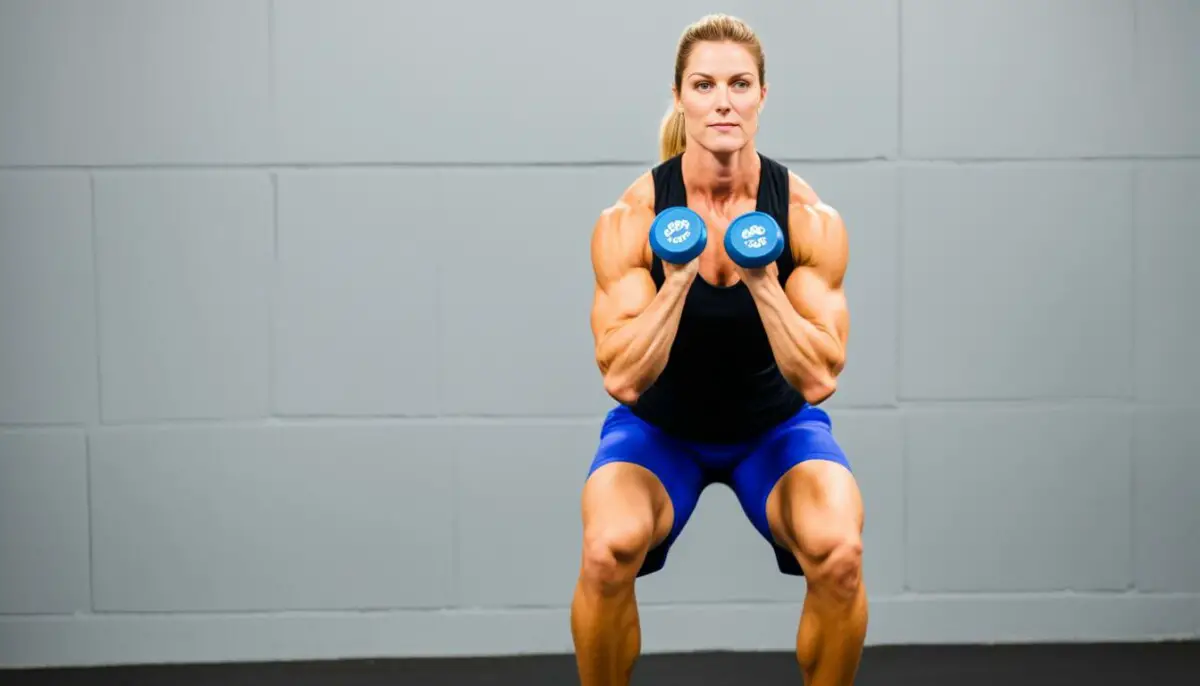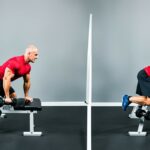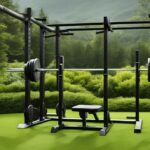Last Updated on 3 months by Francis
Front squats are an effective exercise for building lower body strength and muscle, but they may not be suitable for everyone. If you’re looking for alternatives to front squats, you’re in luck! There are several exercises that can provide similar benefits and help you achieve your fitness goals.
Contents
Key Takeaways:
- There are several effective front squat substitutes that can help you build strength and improve muscle activation.
- Goblet squats, Zercher squats, Bulgarian split squats, hack squats, lunges, leg presses, front rack lunges, dumbbell front squats, and single-arm kettlebell front squats are all viable alternatives.
- These exercises target different muscle groups and can be adjusted to accommodate different fitness levels.
- Experiment with these alternatives to find the ones that work best for your body and preferences.
- Remember to focus on proper form and technique to maximize the benefits of each exercise.
Benefits of Front Squats

Front squats offer numerous advantages over traditional squats. They target the quads, engage the hamstring and glute muscles, and help build lower body strength. Unlike back squats, which place more emphasis on the posterior chain, front squats prioritize the quads, making them an excellent choice for those looking to develop powerful legs.
Additionally, front squats place less stress on the knees and back compared to back squats. This makes them a safer alternative for individuals with knee or lower back issues. By placing the weight in front of the body, front squats encourage a more upright torso position, reducing the risk of excessive forward lean and potential back injuries.
Front squats are also highly effective at building muscle and strengthening the core. The positioning of the barbell in front of the body requires significant core activation to maintain balance and stability throughout the movement. This not only helps develop a strong midsection but also improves overall body control and coordination.
Key Benefits of Front Squats:
- Targets the quads, hamstring, and glute muscles
- Less stress on the knees and back
- Builds lower body strength
- Strengthens the core
- Improves body control and coordination
“Front squats are an excellent exercise for individuals looking to prioritize quad development and strengthen their core. The unique positioning of the barbell in front of the body engages the muscle groups responsible for lower body strength, stability, and control.”
To better understand the advantages of front squats, let’s take a look at a comparison of the key differences between front squats and back squats:
| Front Squats | Back Squats |
|---|---|
| Target quads, activate core | Target posterior chain (hamstrings, glutes) |
| Less stress on knees and back | Greater stress on knees and back |
| Barbell held in front of body | Barbell placed on upper back |
As you can see, front squats provide unique benefits for quad development, core engagement, and reduced stress on the knees and back.
Front Squat Substitutes: Goblet Squat
If you’re looking for a suitable alternative to front squats, the goblet squat is an excellent choice. This exercise not only helps you prepare for the full movement but also provides a great opportunity to focus on form and balance.
To perform a goblet squat, hold a dumbbell or kettlebell in front of your chest with both hands. Keep your elbows tucked in and maintain a strong core throughout the movement. Lower your body by bending at the knees and hips, keeping your chest up and ensuring your knees track over your toes. Then, push through your heels to return to the starting position.
The goblet squat offers several advantages, including:
- Improved form and balance: Holding the weight in front of your chest helps you maintain an upright posture and engage your core, contributing to better overall form and stability.
- Enhanced muscle activation: Goblet squats primarily target your quads, glutes, and hamstrings, making them an effective way to build lower body strength and muscle.
- On-the-go convenience: One of the best things about goblet squats is their flexibility. You can perform them virtually anywhere with minimal equipment, making them a convenient option for busy individuals.
Try incorporating goblet squats into your workout routine as a front squat alternative. Start with lighter weights and focus on mastering the proper technique before gradually increasing the load. Remember to breathe deeply and maintain control throughout each repetition.
| Goblet Squat | Front Squat |
|---|---|
| Focused on form and balance | Engages multiple muscle groups |
| Targets quads, glutes, and hamstrings | Mainly targets quads and engages hamstrings and glutes |
| Convenient for on-the-go exercise | Requires gym equipment or barbell |
As you can see from the table above, while goblet squats excel in honing form and balance, front squats offer the advantage of engaging multiple muscle groups. However, if you’re unable to perform front squats or looking for a variation that requires minimal equipment, goblet squats are an effective alternative.
Front Squat Substitutes: Zercher Squat

The Zercher squat is an effective alternative to front squats that engages different muscle groups and provides unique benefits. This variation involves holding the barbell in the crooks of your elbows, creating a different bar position compared to traditional squats. The Zercher squat allows for increased load and places emphasis on the biceps and upper back muscles, making it a challenging and effective exercise.
While the Zercher squat may initially feel uncomfortable, using a bar pad can help alleviate any discomfort caused by the barbell resting against your arms. By incorporating this alternative into your leg day routine, you can target your lower body muscles in a different way and enhance your overall strength and stability.
“The Zercher squat is one of my go-to exercises for building lower body strength. It’s a great alternative to front squats and provides a unique challenge. Holding the barbell in the crooks of my elbows engages my biceps and upper back, helping me develop functional strength. Give it a try!”
To perform the Zercher squat:
- Start by setting up a barbell in a squat rack at a height that allows you to comfortably lift it into the crooks of your elbows.
- Stand in front of the barbell with your feet shoulder-width apart.
- Take a step back and position yourself so that the barbell is resting against your elbows, just below your biceps.
- Engage your core, brace your abs, and maintain an upright posture.
- Lower your body into a squatting position, ensuring that your knees stay in line with your toes and your hips sink back.
- Drive through your heels to return to the starting position, fully extending your hips and knees.
Remember to start with a weight that challenges you but allows for proper form. Gradually increase the load as you become more comfortable with the exercise.
Below is a breakdown of the benefits and targeted muscle groups of the Zercher squat:
| Benefits | Targeted Muscle Groups |
|---|---|
| Increased load due to unique bar position | Biceps |
| Engages upper back muscles | Upper back |
| Challenges core stability | Abs |
Adding the Zercher squat to your workout routine can provide an effective alternative to front squats. The unique bar position and engagement of different muscle groups make it a valuable exercise for building strength and enhancing overall fitness. Incorporate this squat variation into your leg day routine and reap the benefits of this challenging yet rewarding exercise.
Front Squat Substitutes: Bulgarian Split Squat
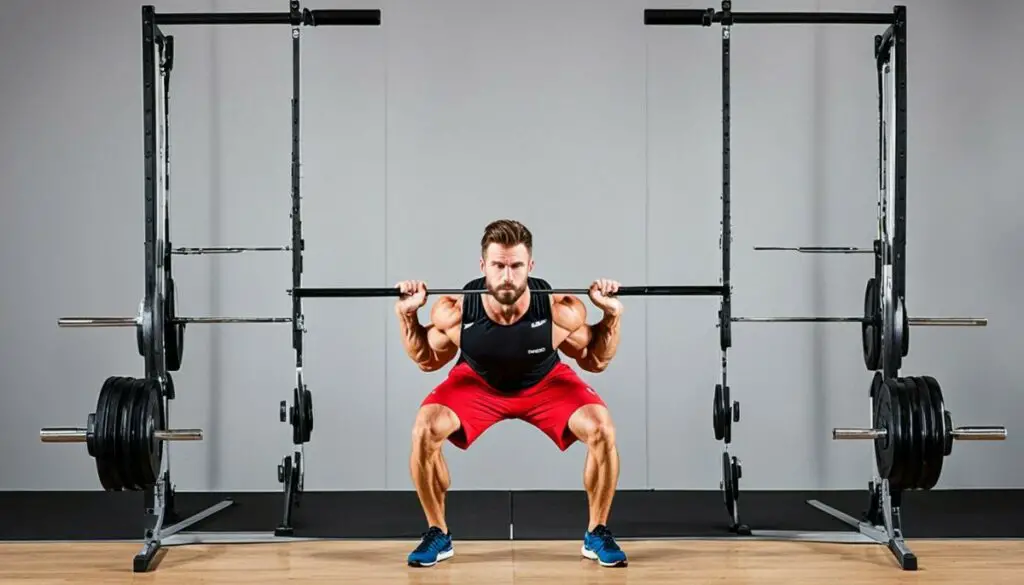
The Bulgarian split squat is a highly effective alternative to front squats that targets the glute muscles and offers numerous benefits. This exercise involves placing one foot on a bench or elevated platform behind you and lunging down with the other leg. It helps build lower body strength, stability, and coordination, making it an excellent option for those looking to strengthen their legs while improving balance.
The Bulgarian split squat is an accessible exercise that can be performed with or without weights. For a more challenging variation, you can use a barbell to perform the barbell Bulgarian split squat, adding an additional load to further enhance muscle activation.
Benefits of Bulgarian Split Squat
The Bulgarian split squat offers a range of benefits that make it a valuable front squat alternative. Some of the key advantages include:
- Targeted muscle engagement: The Bulgarian split squat primarily targets the glutes, quadriceps, and hamstrings, helping to develop strength and size in these muscle groups.
- Improved stability: By performing the Bulgarian split squat unilaterally, you promote greater stability and balance in the lower body.
- Functional movement pattern: This exercise mimics the movements involved in activities such as running, jumping, and climbing stairs, making it highly functional and applicable to daily life.
- Core activation: The Bulgarian split squat engages the core muscles, promoting overall core strength and stability.
- Flexibility development: By lunging down with one leg while keeping the rear leg elevated, the Bulgarian split squat also helps improve hip flexibility and range of motion.
How to Perform the Bulgarian Split Squat
To properly execute the Bulgarian split squat, follow these steps:
- Stand tall with one foot positioned forward and the other foot elevated on a bench or platform behind you.
- Ensure your feet are hip-width apart and your front knee is positioned directly above your ankle.
- Lower your body by bending your front knee and hip, maintaining a straight back and keeping your core engaged.
- Descend until your front thigh is parallel to the ground or slightly below, then push back up to the starting position.
- Repeat the movement for the desired number of repetitions, then switch legs and perform the same exercise on the opposite side.
Remember to maintain proper form throughout the exercise, focusing on slow and controlled movements. If you’re new to Bulgarian split squats, start with bodyweight variations and gradually add weights to increase the difficulty.
With its ability to target the glutes and improve lower body strength and stability, the Bulgarian split squat stands as a valuable alternative to front squats. Incorporate this exercise into your workout routine to diversify your training and continue making progress towards your fitness goals.
Front Squat Substitutes: Hack Squat
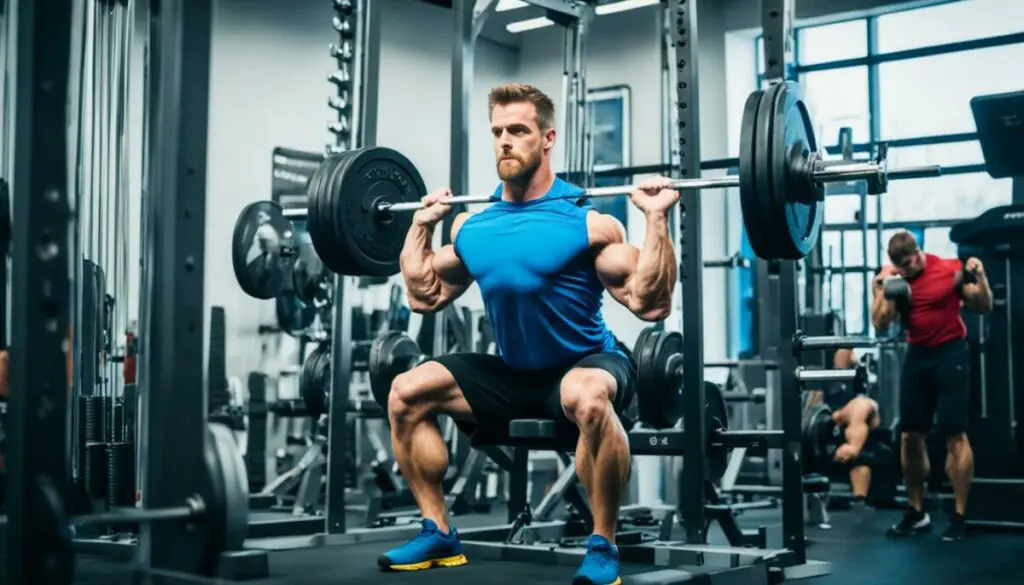
If you’re looking for a front squat replacement that provides stability and targets specific muscles, the hack squat machine is an excellent option. With its adjustable foot positioning, the hack squat machine allows you to customize your workout and focus on different muscle groups. This makes it an effective alternative to the front squat.
The hack squat primarily targets the quads and glutes, helping you build strength and develop muscle definition in these areas. Additionally, the machine provides a stable platform, reducing the strain on your back and making it a safer choice for individuals with back issues.
The hack squat machine can be found in most gyms and fitness centers and is suitable for all fitness levels. Whether you’re a beginner or an advanced lifter, you can adjust the weight and foot placement to challenge yourself and continue making progress.
Make sure to maintain proper form and technique while performing hack squats. Keep your back straight, engage your core, and focus on pushing through your heels to activate your glutes and quads effectively.
When incorporating hack squats into your workout routine, consider combining them with other leg exercises to target a variety of muscles and achieve a well-rounded lower body workout.
To summarize, the hack squat machine is a valuable front squat substitute that offers stability, customization, and targeted muscle engagement. It is particularly beneficial for working the quads and glutes and can be a safer option for individuals with back issues.
Front Squat Substitutes: Lunge
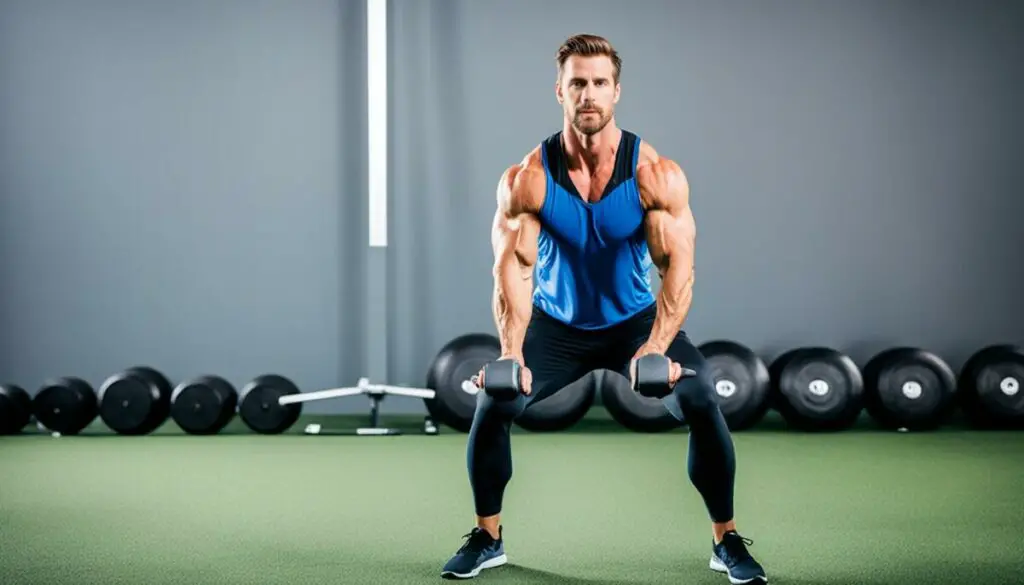
Lunges are a challenging exercise that can be an excellent alternative to front squats. They effectively target the quads, glutes, and hamstrings, helping you build strength and muscle in your lower body. In addition to strengthening your muscles, lunges also improve balance and coordination, making them a well-rounded exercise.
There are two main variations of lunges that you can incorporate into your workout routine: walking lunges and stationary lunges.
Walking Lunges
Walking lunges involve taking a step forward with one leg and lowering your body until your front knee is bent at a 90-degree angle. Then, push off with your back leg and bring it forward to continue the movement. Repeat this sequence for a set number of repetitions or distance.
Walking lunges can be done with bodyweight alone or by adding dumbbells or kettlebells for an extra challenge. This variation engages your muscles differently than traditional squats and can provide a great alternative to front squats.
Stationary Lunges
Stationary lunges are performed by stepping one leg forward and lowering your body until both knees are bent at 90-degree angles. Unlike walking lunges, stationary lunges are performed in place without moving forward or backward. You can perform stationary lunges with or without weights, depending on your fitness level and goals.
Both walking lunges and stationary lunges offer similar benefits to front squats, targeting the same muscle groups while also enhancing balance and coordination.
Whether you choose walking lunges, stationary lunges, or a combination of both, incorporating lunges into your workout routine can provide an effective alternative to front squats. Experiment with different variations, gradually increasing the intensity and resistance as you progress.
Front Squat Substitutes: Leg Press Machine
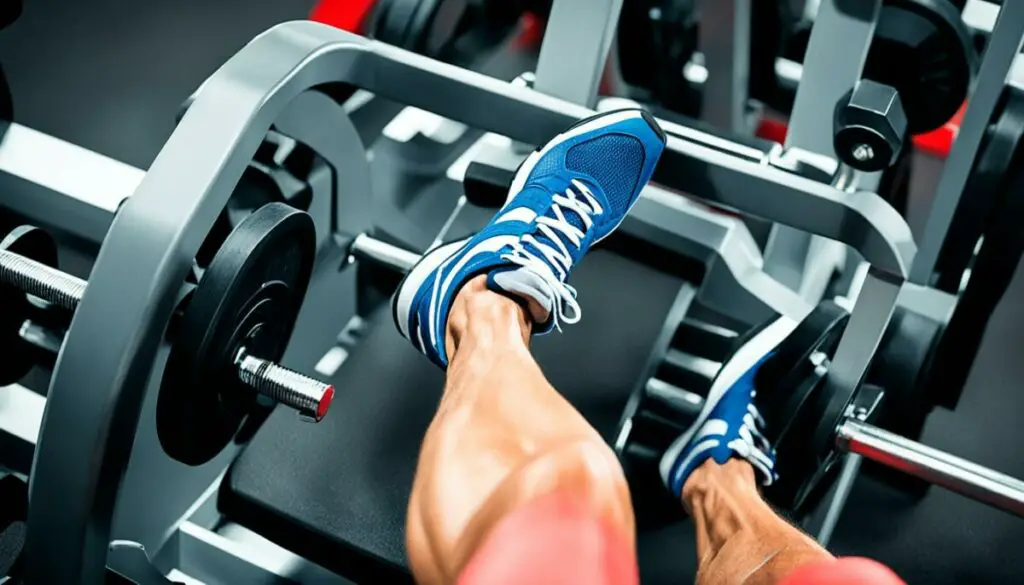
The leg press machine is a popular alternative to front squats that can provide a challenging and effective workout for your legs. This machine allows you to perform leg press exercises using controlled, guided movements.
One of the advantages of using a leg press machine as a front squat substitute is that it provides stability and support, which can be especially beneficial for individuals with balance issues or those recovering from injuries. The machine’s design ensures that your movements are controlled and targeted, allowing you to focus on working specific muscle groups.
The leg press machine can also be adjusted to target different muscle groups. By adjusting the foot positioning and the weight load, you can emphasize your quads, hamstrings, glutes, or calves, providing variety and allowing you to target specific areas of your legs.
The leg press machine is particularly effective for building leg strength and muscle mass. It engages the quads, hamstrings, and glutes, helping you develop strong and well-defined legs.
Benefits of Leg Press Machine:
- Provides stability and support during the exercise
- Targets specific muscle groups, allowing for customization
- Allows for controlled and guided movements
- Engages the quads, hamstrings, and glutes
- Helps build leg strength and muscle mass
If you’re looking for a front squat alternative that can help you build leg strength and muscle mass, the leg press machine is a great option. Incorporate it into your training routine to add variety and challenge to your leg workouts.
Front Squat Substitutes: Front Rack Lunge
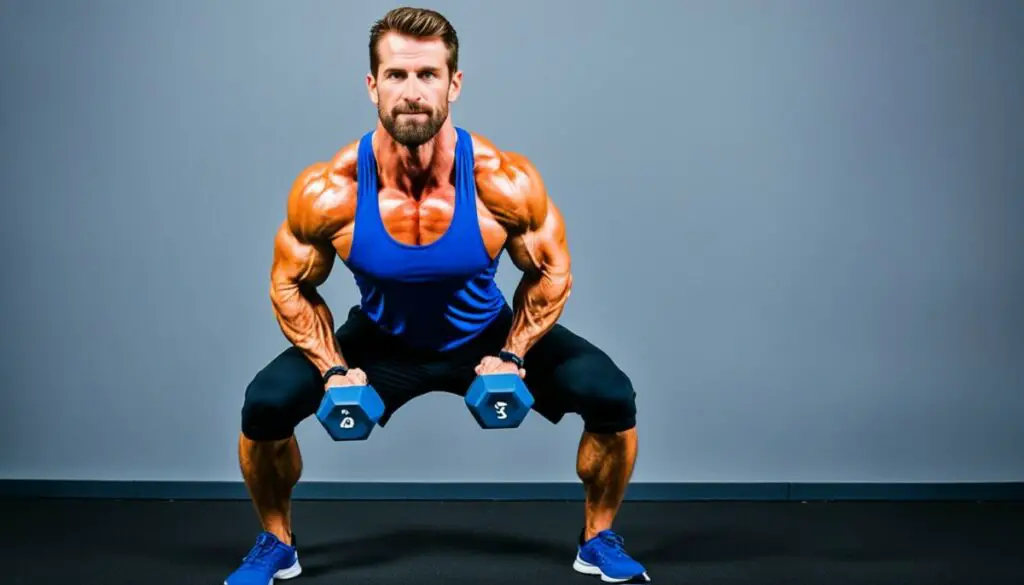
The front rack lunge is an excellent alternative to front squats that combines the benefits of lunges with the stability of front-loaded exercises. By holding a barbell in the front rack position, you can perform lunges that target the quads, glutes, and hamstrings, while also engaging the core and upper back muscles.
The front rack lunge is a dynamic movement that challenges your lower body strength, stability, and balance. It requires proper form and control to execute effectively. Begin by standing tall with a barbell across your front shoulders, holding it securely with your hands shoulder-width apart. Take a step forward with one leg, lowering your body until both knees are at around a 90-degree angle. Push through the front foot to return to the starting position and repeat with the opposite leg.
This exercise is an excellent alternative to front squats because it mimics the movement pattern while providing additional stabilization benefits. By performing front rack lunges, you can develop strength and mobility in your lower body while also challenging your core and upper back muscles.
“The front rack lunge activates a variety of muscles in the upper and lower body, making it a highly effective exercise for overall strength and stability.” – Fitness Expert
Benefits of Front Rack Lunges:
- Targets the quads, glutes, and hamstrings
- Engages the core and upper back muscles
- Improves lower body strength and stability
- Enhances balance and coordination
Front rack lunges can be performed with various weights, making them suitable for individuals of different strength levels. Whether using a barbell or dumbbells, this exercise can be modified to suit your fitness goals and preferences. Incorporate front rack lunges into your workout routine as a challenging alternative to front squats, and enjoy the benefits of improved strength, stability, and overall fitness.
Front Squat Substitutes: Dumbbell Front Squat
The dumbbell front squat is a convenient alternative to front squats that can be performed at home or in the gym. This exercise provides an effective way to target the lower body muscles and achieve similar benefits to front squats. By holding dumbbells in a front rack position and performing squats, you can build strength, improve muscle activation, and enhance your overall fitness.
One of the advantages of the dumbbell front squat is its versatility. It can be adjusted to accommodate different fitness levels by using lighter or heavier dumbbells. This allows individuals of all abilities to reap the rewards of this exercise. Additionally, the dumbbell front squat helps improve balance and stability as you engage your core muscles to maintain proper form.
To perform the dumbbell front squat:
- Start by standing with your feet shoulder-width apart and hold a dumbbell in each hand at shoulder height, with your elbows pointed forward.
- Keep your chest up and your back straight as you descend into a squat position, making sure your thighs are parallel to the ground.
- Push through your heels and engage your glutes as you return to the starting position.
- Repeat for the desired number of repetitions.
The dumbbell front squat can be incorporated into your leg or full-body workout routine. It can be performed as a standalone exercise or combined with other squat variations for added variety and challenge.
If you prefer visual guidance, here’s an example of how the dumbbell front squat is performed:
Remember to start with a weight that challenges you but still allows for proper form. As you become more comfortable with the exercise, you can progressively increase the weight to continue challenging your muscles and promoting growth.
By including the dumbbell front squat as part of your workout routine, you can effectively target your lower body muscles and achieve similar benefits to front squats.
Front Squat Substitutes: Single-Arm Kettlebell Front Squat
The single-arm kettlebell front squat is an excellent alternative to traditional front squats that can provide a challenging workout for your lower body. This unilateral exercise focuses on targeting specific muscles and promoting stability and balance.
To perform the single-arm kettlebell front squat, start by holding a kettlebell in one hand in the front rack position, with your elbow bent and the kettlebell resting against your upper chest. Keep your feet shoulder-width apart and your core engaged, then bend your knees and hips to lower into a squat position. Drive through your heels to return to the starting position, and repeat for the desired number of reps.
This exercise is particularly effective for building strength in the quads, glutes, and hamstrings. The unilateral nature of the movement challenges the muscles on one side of the body at a time, helping to correct any imbalances that may exist.
Here is a table highlighting the key benefits of the single-arm kettlebell front squat:
| Benefits of Single-Arm Kettlebell Front Squat |
|---|
| Targets the quads, glutes, and hamstrings |
| Promotes stability and balance |
| Helps correct muscle imbalances |
| Can be modified to accommodate different fitness levels |
Adding the single-arm kettlebell front squat to your workout routine can provide a challenging and effective alternative to traditional front squats. Incorporate this exercise into your lower body workouts to target specific muscles and enhance your overall strength and stability.
Conclusion
Front squats are a popular exercise for building lower body strength, but they may not be suitable for everyone. Thankfully, there are several effective front squat substitutes that can provide similar benefits. Goblet squats, Zercher squats, Bulgarian split squats, hack squats, lunges, leg presses, front rack lunges, dumbbell front squats, single-arm kettlebell front squats, and front squat holds are all viable options to consider.
These alternative exercises can help you build strength, improve muscle activation, and achieve your fitness goals without the need for front squats. Whether you’re looking to target specific muscle groups, improve stability and balance, or work with minimal equipment, there is a front squat substitute that will suit your needs. Experiment with these alternatives to find the ones that work best for your body and preferences.
Remember, it’s important to listen to your body and consult with a fitness professional if you have any concerns or specific conditions. The key is to find exercises that challenge you and contribute to your overall fitness journey. So, don’t be afraid to try out these front squat substitutes and discover new ways to enhance your lower body training.
FAQ
What are some effective front squat substitutes?
Some effective front squat substitutes include goblet squats, Zercher squats, Bulgarian split squats, hack squats, lunges, leg press machine, front rack lunges, dumbbell front squats, and single-arm kettlebell front squats.
What are the benefits of front squats?
Front squats are great for building lower body strength, particularly in the quads. They also engage the hamstring and glute muscles, help in building muscle and strengthening the core, and place less stress on the knees and back compared to traditional squats.
What is a goblet squat and how can it replace front squats?
A goblet squat involves holding a dumbbell or kettlebell in front of your chest. It is a great alternative to front squats as it allows you to focus on form and balance, can be done anywhere with minimal equipment, and helps you prepare for the full movement.
How does the Zercher squat replace front squats?
The Zercher squat involves holding the barbell in the crooks of your elbows. This unique bar position engages the biceps and upper back muscles, provides increased load, and is an effective front squat substitute. Using a bar pad can help alleviate any discomfort.
What is a Bulgarian split squat and how does it substitute front squats?
The Bulgarian split squat targets the glutes and is performed by placing one foot on a bench or elevated platform behind you and lunging down with the other leg. This exercise helps build lower body strength and stability, improves balance and coordination, and is a good alternative to front squats.
How can a hack squat machine replace front squats?
The hack squat machine provides a stable platform and allows you to adjust foot positioning to target different muscles. It is particularly beneficial for working the quads and glutes, and can be a safer option for individuals with back issues who are looking for a front squat substitute.
What are the benefits of lunges as a front squat alternative?
Lunges are a challenging exercise that target the quads, glutes, and hamstrings. They also improve balance, coordination, and can be performed with or without weights, making them an effective alternative to front squats.
How does the leg press machine replace front squats?
The leg press machine allows you to work your legs using controlled, guided movements. It can be adjusted to target different muscle groups and provides stability and support, making it an effective substitute for front squats.
What is a front rack lunge and how does it substitute front squats?
The front rack lunge involves holding a barbell in the front rack position and performing lunges. This exercise targets the quads, glutes, and hamstrings, while also engaging the core and upper back muscles. It combines the benefits of lunges with the stability of front-loaded exercises as a front squat alternative.
How can dumbbell front squats replace front squats?
Dumbbell front squats involve holding dumbbells in a front rack position and performing squats. They are a convenient alternative to front squats that can be performed at home or in the gym. By using lighter or heavier dumbbells, this exercise can be adjusted to accommodate different fitness levels.
What is a single-arm kettlebell front squat and how does it replace front squats?
The single-arm kettlebell front squat is a unilateral exercise that targets the lower body muscles, promotes stability and balance, and can be performed with a kettlebell held in one hand in the front rack position. This front squat substitute challenges the muscles on one side of the body at a time, helping to correct any imbalances.
What are some viable options as front squat substitutes?
Goblet squats, Zercher squats, Bulgarian split squats, hack squats, lunges, leg presses, front rack lunges, dumbbell front squats, single-arm kettlebell front squats, and front squat holds are all viable options as front squat substitutes.

